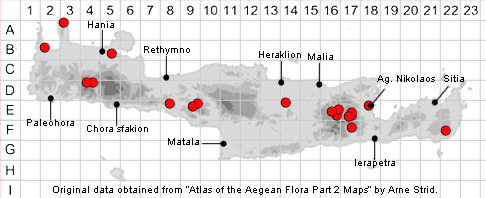
RANUNCULUS ARVENSIS
Family and Genus:- See- RANUNCULACEAE/Subgen. RANUNCULUS/Sect.
Common Names:- Corn buttercup, Corn crowfoot.
Homotypic Synonyms:- None
Meaning:- Ranunculus (L) Little-frog, diminutive of rana, (reference to the water-
loving habit of many species).
Arvensis (L) Of the cultivated/ploughed field.
General description:- Erect annual.
Stem:-
1) 10-45 cm. usually sparingly branched from the middle, subglabrous towards
the base, sparsely pubescent in the upper part.
Leaves:-
1) Basal, lamina varying from elliptic-obovate and subentire to deeply 3-partite.
2) Cauline, lamina, ± equalling the petipole, divided to the base into 3 oblanceolate
lobes.
3) Upper, dissected into linear-oblanceolate segments.
Flowers:-
1) Several, on slender, terete pedicels equalling or exceeding the subtending leaf.
2) Sepals, 4-5 mm, appressed, elliptic, pilose.
3) Petals, 4-7 mm, obovate, obtuse, pale yellow.
4) Receptacle, sparsely pilose.
Fruit:-
1) Achenes, few (3-7), short-stipitate in a subglobose head.
a) body, c. 5 x 4 mm, compressed, brown, with prominent, stramineous spines
up to 3 mm long and often uncinate, rarely muricate, or tuberculate.
b) beak 2-3 mm, slender, falcate.
Key features:-
1) Lamila, of the lower cauline leaves divided to the base into 3 oblanceolate lobes
which are 3-fid or 3-dentate.
2) Petals, 4-7 mm, obovate, obtuse, pale yellow.
3) Body of the achene, with prominent, stramineous spines up to 3 mm long and
often uncinate.
Habitat:- Cultivated and fallow fields, sometimes olive groves, orchards, and semi-
natural habitats, (gorges, dry open shrubby vegetation). 0-1000(-1600) m.
Distribution:- Throughout Greece, though declining in many areas, but still
common in the north. - Europe and SW Asia to C Asia. Limited occurrence on
Crete, mainly around the arable regions of Lasithi and Katharo, scattered
elsewhere.
Formerly a common weed of cereal fields in C. Europe, this species is now
threatened by the wide use of herbicides and is also becoming rare in parts of
Greece.
Flowering time:- Apr to early June.
Photos by:- Steve Lenton
SPECIES DESCRIPTION
